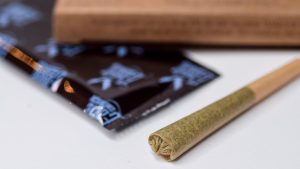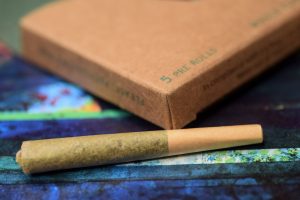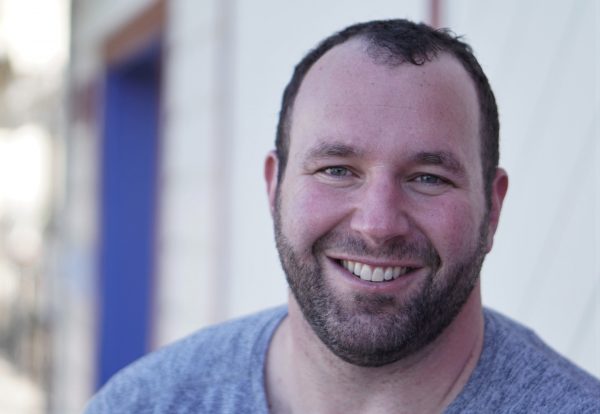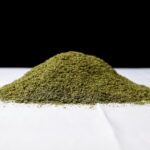The first PhD in America with certified technical expertise in growing commercial cannabis, Flannery talks good science, clean cannabis, and the launch of his initial pre-roll brand, Eagle.
In college, he couldn’t smoke because he was a football player, but Dr. Robert Flannery, founder and chief executive officer of Dr. Robb Farms, always had a suspicion that he would end up in the cannabis industry. He instinctively understood that the plant was different, but it wasn’t until he was a graduate student at the University of California, Davis, researching hydroponics and cutting-edge technologies for growing plants more efficiently, that his knowledge really deepened. Soon, clandestine but curious cannabis farmers were swarming the 39-year-old academic, inquiring about his greenhouse practices. When he asked them what they were growing, they would reply, “French Basil.”
“French Basil became our term for cannabis,” Flannery recalled with a chuckle. “But when we casually discussed its possible growth in our new hydroponic systems, I started realizing, ‘I am training myself to grow weed one day, aren’t I?’
PART 1: THE MAKING OF A CANNABIS DOCTOR
mg: You are the first PhD in the U.S. with certified technical expertise in growing commercial cannabis. How did that come about?
Dr. Robb: I may not look the part, but I’m a big nerd. I played football at UC Davis, which has a long history of recruiting athletes who are just as strong off the field as they are on. I ended up as two-time All-American and Academic All-American my senior year. I was then recruited into the PhD program in the Plant Biology Graduate Group at UC Davis. My graduate advisor used to tease me that the only reason he recruited me into his lab was because I would be capable of moving heavy lab equipment for him.
He must have seen something else in you, too.
My PhD is in plant biology with an emphasis in environmental horticulture with a specific expertise in hydroponic crop optimization for cut-flower production. In other words, I’m literally trained by the top plant science school on the planet to grow weed. I always knew that I would find myself in higher education for plant biology, but I wasn’t sure that it would be in an applied science like horticulture until I did my rounds in a genetics lab as an undergrad.
Don’t get me wrong. I learned a tremendous amount in that lab, and I am very grateful for the opportunity. However, I very quickly learned that I’d rather be getting my hands dirty with roses than Arabidopsis thaliana in a sterile growth chamber in the basement of the genetics building. It was really my interest in integrating technology and agriculture that led me to horticulture. That and a great professor that I was lucky to find who just so happened to be an expert in cut-flower production. Remember, cannabis cultivation is nothing more than cut-flower production.
So, you really are a cannabis nerd!
Yes, I’m a nerd that loves flowers. Ask my wife about the roses that I used to grow at my college apartment. A longer response would be that I’ve always been very interested in integrating technology with agriculture. I just so happened to be lucky enough to find a professor who also had that same passion. Also, I’m fairly decent at mathematical modeling, which led to working in the lab that I did.
Who was your teacher?
Dr. Heiner Lieth. In fact, each spring I give a lecture in his Flower Power class about cannabis. It’s great because Heiner starts off the lecture by talking about medicinal flowers. He says, ‘I’m not going to talk about that plant you all are thinking about.’ Then he introduces me as a guest lecturer to which I start off by saying, ‘Dr. Lieth told you that he would not be talking about cannabis, but he never said I wouldn’t be.’ At this point I project on the screen what comes out to be a 10-foot cola (adjusted for projection size) of one of my favorite Jack strains right after harvest. The demeanor of the 300 students changes at that point.
What was your lab or testing facility like?
All my research was done in controlled environment systems—greenhouses and environmental control chambers, which are just basically fancy warehouses. I studied roses and chrysanthemums and was primarily funded through the International Cut-Flower Growers Association. I studied oxygen concentrations in the root zone of these hydroponically grown crops, and mathematically modeled their use of oxygen. I had to utilize novel technology to finish out my research in order to sense dissolved oxygen concentrations in real time.
Are you still the only person with a PhD in cannabis?
That’s a good question. There aren’t too many whole plant physiologists with expertise in hydroponic crop optimization for cut-flower production to begin with. It seems like a disproportionate number of plant biology PhD’s are moving towards molecular and genetics research. I do know, however, that there are other PhD’s working in the cannabis industry on the cultivation side, but it is my understanding that their PhD’s are in microbiology and genetics.
You took a job at the San Francisco dispensary SPARC as Production Director. What did you learn there?
When I joined SPARC is when I truly discovered the magic of cannabis. SPARC is fairly unique in that patients are allowed to medicate on site. It was common for me to see patients with severe ailments and help them find immediate relief by vaping right in the lounge. It was at SPARC that I came to understand what I would be doing for the rest of my life. I oversaw the largest department in the company and managed every aspect of production from maintaining genetics, cloning, vegging, flower production, harvest, post-harvest biology, dry/cure, trimming, manufacturing, assembly, storage, and delivery of final product to retail.
You then began consulting with growers up and down the California coast, right?
Yes. Entering the cultivation space was a bit of a shock for me, though. I have been involved with controlled environment agriculture management since 1999 and have seen all kinds of production, but cannabis growers threw me back a bit. I started consulting with cultivators throughout the state and quickly realized that most growers were extremely innovative in their methods and more often than not very secretive of their grow techniques.
On one farm, the owner asked me to sign a [non-disclosure agreement] because in order for me to diagnose some production issues, they were going to have to tell me their secret sauce. I told him that I already knew what their secret sauce was: They were using a plant growth regulator (PGR) to keep their “nugs tight.” Come to find out the PGR they were using also happened to be a suspected mutagen, which was why he wanted me to stay quiet about it.
Were you shocked what you found in the flower of these farmers?
Unfortunately, running into growers who knowingly were adding compounds that were turning the medicine into poison was not an isolated incident. I would inform the farmers of the situation. Luckily, some would ask about alternatives that they could use. Unfortunately, more farmers than I would expect would say, ‘I don’t care.’ This utterly flabbergasted me.
When your mom was diagnosed with cancer, is that when you really got into the importance of clean cannabis?
When I was still at SPARC my mom was diagnosed with breast cancer. I told her that I wanted her to consider using cannabis. Well, she wanted edibles. All of the product that I had grown and that I knew was free from pesticides and plant growth regulators was all meant for smoking or vaping. This meant I was going to have to source clean product for my mom from another grower. With my experiences with cannabis growers at the time, I immediately thought to myself, ‘Am I about to poison my mom?’
Is this when the idea for your own farm and brand came about?
Yes. I have the technical training to grow this plant without using these compounds, while not losing out on the many benefits they provide. I can cultivate clean cannabis using good science, which means that providing clean cannabis to the market would not also mean a significant decrease in yield. I knew my mom was not an anomaly. There are more people like my mom out there that wanted access to clean cannabis.
You are also a big crusader for sustainability.
Yes. Being a good environmental steward is very important to me. I’m particularly interested in LED use in supplemental lighting to reduce energy demands for production. Additionally, I’m currently tinkering with a way of running the controlled environment a bit warmer than is typical for production in an attempt to reduce cooling needs without compromising the quality of production. One thing we’ve recognized is that this may also have the added benefit of decreasing spider mites’ ability to takeover an entire crop.
You are a big proponent of sun grown. Why?
First and foremost, the sun is free. Secondly, the sun has a fuller light spectrum than we typically see in HID (High Intensity Discharge) lamps. We have seen evidence that suggests that sun-grown cannabis has a more complex spectrum of cannabinoids and terpenes as well. I am not certain if that is due to the wider light spectrum promoting different bio-signal pathways that creates the wide variety of compounds, or if it is due to parts of the sun’s light spectrum, UV specifically, that might promote the degradation of cannabinoids and terpenes into other varieties. I know that may sound bad, but it’s generally a good thing.
You are also involved in advancing the greenhouse technology, right?
Yes. We are currently developing a highly advanced, state-of-the-art group of greenhouse production facilities in Southern California. What I’m the most proud about with these facilities is the section of the facility that is strictly dedicated to cannabis and analogous plants research. We are currently in discussions with a particular university to collaborate with on the research.
 PART 2: THE EAGLE HAS LANDED
PART 2: THE EAGLE HAS LANDED
Talk about Eagle, your first pre-roll launch. Why now, why pre-rolls?
Historically, pre-rolls were made from lower-quality flower or trim. Trim typically has lower cannabinoid content. We also see pre-rolls that are filled with trim and some type of extraction, or they coat the cones with kief. In fact, that was one of the first questions I got. ‘Where’s the kief?’ All kief is in the trichomes—plant hairs that primarily contain the cannabinoids and terpenes—that fall off the flowers. We use whole flowers for Eagle by Dr. Robb, so the kief is already inside the cone.
You also guarantee that all flower is pesticide free.
Yes. That is the last thing I want the consumer to be thinking about when they buy any Dr. Robb Farms product.
You also were one of the first pre-roll companies to come up with effective child proof packaging.
Yes, the science behind the packaging really sets them apart from the rest of the pre-rolls in the market. Our pre-rolls are each individually sealed to prevent light and oxygen degradation so that when each pre-roll is opened it is as fresh as the day it was packed.
When it comes to marketing, what’s your philosophy?
Our marketing strategy really starts with the product itself. I put my name on every pre-roll that goes into the market so it has to be clean and high-quality flower. I believe in having beautiful packaging and strong marketing, but nothing beats a personal recommendation from a customer. I’ve always been fond of the marketing strategy of pondering this question: You buy your headphones from a doctor. Why not buy your medicine from one, too?
With your launch in California, are you using a distribution company?
Yes, we are using Old Kai Logistics. Their diligence for doing what is right is a perfect fit for how we work as well. They are exceedingly professional. They embrace progress and moving into the future of cannabis while still maintaining a firm understanding and foothold in the history of California cannabis.
When it came time for design and packaging who did you turn to?
I worked with a company called Big Design. They are a fantastic partner and they also meet the requirements of my golden rule. I hope consumers understand from our packaging that they are going to get the freshest and cleanest pre-rolls on the market.
I know your grandfather was a big influence behind Eagle.
My grandfather was born and raised on the island of Malta in the Mediterranean Sea. He came the America just before WWII broke out. He wanted to become an American citizen, so he joined the Army. He ended up in the 101st Airborne and was one of the paratroopers who parachuted far behind enemy lines in Normandy on D-Day. As he was fighting his way back to the front lines, he came under attack. A grenade ended up blowing off his arm just below the elbow and knocked him unconscious. He came to to find German soldiers taking his gun and boots.
He played dead as the soldiers that he was dead, and understandably so. His arm was missing and he was bleeding out. He played dead until he recognized American boots running by. He jumped up, grabbed a pistol off a fellow soldier, and fought his way back to safety. He was ready to continue fighting, but he was informed that would not be an option since he was missing his arm. He was so proud of what he had done and sacrificed for his country, he had a huge American Eagle tattooed across his chest. My grandfather ended up dying from brain cancer in his late 80s. He never had access to cannabis to help him in his final days. I created Eagle by Dr. Robb in honor of his memory.
Talk about how your Mom’s Formula and how it came about?
As the name suggests, this product is for my mom and for people like her. When my mom was going through her cancer treatments, she relied on edibles to help her go to sleep and maintain her appetite. She was sincerely grateful for this medicine, but one thing she needed help with was dosing. For most edibles, they come in large doses that the consumer has to break apart and hope they’re getting a similar dose time after time.
Mom’s Formula is a micro dosing CBD tablet that is not meant to get you high. It’s meant to give a general feeling of well-being that typically is associated with CBD. And since it’s a small dose, it really brings you down a notch on the anxiety scale. Mom’s Formula is meant to be taken with your daily multivitamin and fish oil pills.
When we got the first samples, I handed them out to friends and family. The response we received was overwhelmingly positive.
 Part 3: THE ART OF GOOD SCIENCE AND CLEAN CANNABIS
Part 3: THE ART OF GOOD SCIENCE AND CLEAN CANNABIS
Okay, let’s get down to business: What is Dr. Robb’s secret sauce?
Ha! I won’t give away too much secret sauce as my business partners would be rather upset with me. However, my specific expertise really is all about optimization. This means increasing and maintaining high yields while not compromising quality. I primarily utilize the understanding of crop production—modular vs. unitary organism population models. There are also ways to manipulate the plants to preferentially allocate carbon to the shoots as opposed to the roots without compromising production yields. When it comes to pests, I’m a big fan of Integrated Pest Management. IPM utilizes understanding the pests’ biology and using an ecosystem approach to promote long-term pest mitigation. Using beneficial organisms, controlling the abiotic environment in favor of reducing pest populations/decreasing the probability of fungal spore germination, etc. are all part of IPM. Prevention is key.
In the end, what I like to do is integrate as much science and technology as I can. I will grow primarily using the tried and true methods that we’ve typically seen in cannabis cultivation thus far, but there will always be a portion of my grow that is dedicated to trying new things out. If my experimental crop shows that a method is of some benefit to either quality or crop yield, into the SOPs it goes.
You’ve always been big on experimentation. Why?
My growing methods are a combination of tried and true, evidence-based, scientific approaches in combination with a willingness to experiment, tinker, and having a deeper than usual understanding of how crop ecology works. When you hear that someone sings or plays music for their plants to get them to grow better, I understand that there’s likely more correlation than causation in effect here. If you’re willing to go to the lengths of singing to your cannabis crop, you’re also likely doing things that actually do benefit their growth. I’m always going to be interested in pursuing the causation, not the correlation.
Are you bullish or bearish about the state of clean cannabis in California?
It’s a bull market, baby! Maybe I’m just overly optimistic, but I sincerely see the trends of more and more cultivators doing things the right ways when it comes to clean cannabis. The California Cannabis market has a long way to go, but I see it as going in the right direction for promoting wellness and health as opposed to just getting stoned at the potential cost of also consuming some pretty harsh chemicals.
Finally, if a young grower came to you for advice what would you tell them?
I’d say, all you have to do is get yourself a PhD in plant biology with an emphasis in environmental horticulture and a specific expertise in hydroponic crop optimization from UC Davis. Ha! Seriously, though, it’s all about knowledge. Knowledge is power!










